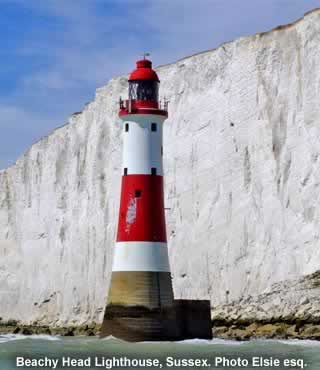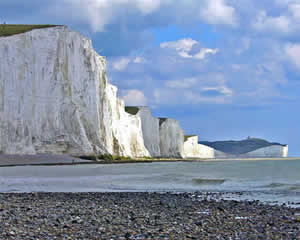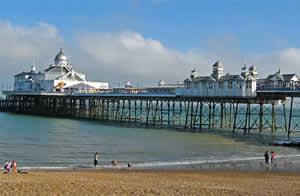Sussex |
|
 |
|||
An area of Britain that takes up a large chunk of England's south coast with towering cliffs and rolling hills |
Listen to this article |
Sussex is an area of Britain that takes up a large chunk of England's south coast. The shoreline is varied and diverse, moving between sand, shingles, and tall rocks. One of the most notable locations here is at Beachy Head, which is the highest coastal chalk cliff in Britain. Immediately next door to this are the Seven Sisters, another series of gleaming white cliffs that have been used in film and television as a replacement for the more well-known examples at Dover. |
 The Seven Sisters Photo jonnyr1 |
Just a kilometre or so along from here, the high chalk slopes away, and turns into the popular sands of Eastbourne. This is just one of the many seaside towns along the Sussex coast, which continue to be much loved by the British public. Eastbourne is somewhat different to the stereotype of such resorts, in that its seafront hasn't been taken over by gift shops and amusement arcades. Instead, the beach is lined with old Victorian hotels, giving the town a more elegant, relaxing ambience. |
 Eastbourne Pier Photo usm_photos |
Of course, Sussex's shoreline also features several towns with all the entertaining, lively characteristics of a typical seaside resort. Loudest and brightest of them all is Brighton, which is also the the biggest settlement in the region. It mixes the sun and sand with the amenities and atmosphere of a city, making for an unmissable destination for any visitor to the Sussex coast. Brighton is known as being an especially youthful, vibrant place. With its wide programme of music, theatre, and comedy events, it is the artistic and cultural centre of the region - and arguably of the entire south coast. May's arts festival is almost as big as Edinburgh's, making this a particularly good time to visit. |
But there's more to Sussex than just its coastline. Inland, there are unspoilt woods, pleasant villages, and flat, expansive areas of downland. A good example of the gorgeous natural surroundings is at Ashdown Forest, which includes several thousand acres of heathland that has never been subjected to a plough. The woods themselves helped to inspire A.A. Milne's Winnie the Pooh stories, which were all set in the local area. Fans should visit the village of Hartfield, which contains several shops and sights relating to the honey-loving bear. |
Elsewhere in the Sussex inland, you might stumble across a huge picture of a man, cut into the turf. This figure, which is nearly 70 metres tall, is called The Long Man of Wilmington, and is estimated to date from the 16th or 17th century. |
This would have been back when Sussex was still an official county. Today, following an official split in 1974, the same area is occupied by the two separate counties of West and East Sussex. Although the historic county no longer exists, the area's long and interesting past is still in plain sight. This is especially true in "1066 country", which is the name given to the area where the famous Battle of Hastings was fought. There are several charming old towns here, as well as churches, castles, and museums. Fans of architecture will also enjoy a visit to Chichester, West Sussex's only city, which contains a cathedral built with a combination of the Norman and Gothic styles. |
There's a lot to see in the two counties of West and East Sussex. But statistically, there are more hours of sunshine here than in any other part of the UK - so you've got lots of time to go sightseeing! |
|
Pocket Britain is optimised for use on a smartphone or tablet with internet access. All content is subject to copyright. All reasonable methods have been used to ensure information supplied is accurate at the time of publication. However, it is advisable to check information before relying on it. Privacy Policy |